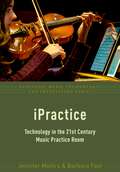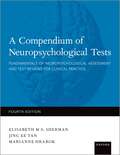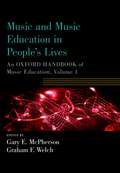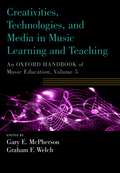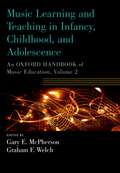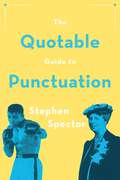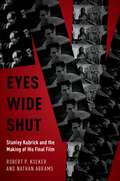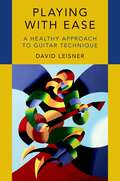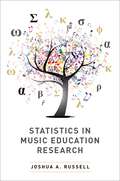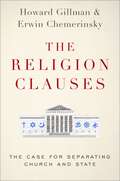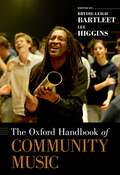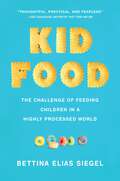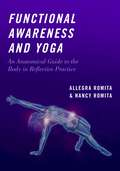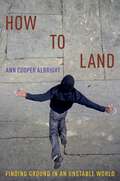- Table View
- List View
IPRACTICE TECHNOLOGY IN 21ST CENT EMT C: Technology in the 21st Century Music Practice Room (Essential Music Technology:The Prestissimo Series)
by Jennifer Mishra Barbara FastThis book provides new practical tools that bridge the gap between familiar, easy-to-use technology and musical practice to enhance musicianship and motivate students. Authors Jennifer Mishra and Barbara Fast provide ideas for use with students of all levels, from beginners to musicians performing advanced repertoire. This book is written for teachers (both studio teachers and ensemble directors), but can be read by performers to help give new guidance to their own practice sessions. Some strategies in this book would not have been possible without advances in technology; others expand tried-and-true practice strategies with the use of technology. Most of the technologies discussed are free or inexpensive and don't require extensive specialist equipment or learning. Rather than replacing quality practice strategies, technology brings new tools to the practicing tool box. The strategies lay the foundation for how technology can be used in the practice room and are intended to spark creativity. The book encourages teachers and students to vary the integration of practice strategies with technology in personal ways to fit their own studios or practice routines. This book is all about exploring our musical practice through technology. The ideas in this book will invigorate your musical practice and lead to even more creativity between you and your students
A Compendium of Neuropsychological Tests: Fundamentals of Neuropsychological Assessment and Test Reviews for Clinical Practice
by Elisabeth Sherman Marianne HrabokThe Compendium is an essential guidebook for selecting the right test for specific clinical situations and for helping clinicians make empirically supported test interpretations. BL Revised and updated BL Over 85 test reviews of well-known neuropsychological tests and scales for adults BL Includes tests of premorbid estimation, dementia screening, IQ, attention, executive functioning, memory, language, visuospatial skills, sensory function, motor skills, performance validity, and symptom validity BL Covers basic and advanced aspects of neuropsychological assessment including psychometric principles, reliability, test validity, and performance/symptom validity testing
CONTEMP HEALTH ISSUES ON MARIJUANA C
by Kevin A. Sabet and Ken C. WintersMarijuana is the most commonly used illicit drug in the United States. A growing number of Americans now perceive marijuana as relatively harmless and the notion that the drug should be legalized it is becoming increasingly popular. As policy in this area remains dynamic, resulting health issues, including the harm to adolescents and the potential for compounds to have therapeutic value, become more salient. Contemporary Health Issues on Marijuana is a balanced, empirically driven volume that highlights new and meaningful theory and evidence pertaining to marijuana use. Authored by a multidisciplinary group of experts from the fields of psychology, epidemiology, medicine, and criminal justice, chapters comprehensively review numerous research domains of public health interest with respect to marijuana use, including the drug's impact on cognitive and neurological functioning, its medical effects, treatment approaches for cannabis use disorders, the effects of marijuana smoking on lung function, and marijuana-impaired driving. The book concludes with a chapter on policy implications, taking stock of current trends and anticipating prevalence rates and resulting health consequences that will only continue to grow. Contemporary Health Issues on Marijuana is a resource of great clinical, scientific, and public policy value that will be a must-have for researchers, practitioners, and policymakers alike.
Music and Music Education in People's Lives: An Oxford Handbook of Music Education, Volume 1 (Oxford Handbooks)
Music and Music Education in People's Lives is one of five paperback books derived from the foundational two-volume Oxford Handbook of Music Education. Designed for music teachers, students, and scholars of music education, as well as educational administrators and policy makers, this first book in the set provides a framework for understanding the content and context of music education, and for future action within the profession. A broad examination of the philosophical, psychological, cultural, international, and contextual issues that underpin a wide variety of teaching environments or individual attributes is paired with 25 relevant and insightful commentaries from established scholars and music educators. Taken as a whole, Music and Music Education in People's Lives gives clear direction to how the discipline of music education can achieve even greater political, theoretical and professional strength. Contributors Harold F. Abeles, Nick Beach, Wayne D. Bowman, Liora Bresler, Patricia Shehan Campbell, Richard Colwell, Robert A. Cutietta, David J. Elliott, Sergio Figueiredo, Lucy Green, Wilfried Gruhn, David Hargreaves, Sarah Hennessy, Liane Hentschke, Donald A. Hodges, Christopher M. Johnson, Estelle R. Jorgensen, Andreas C. Lehmann, Richard Letts, Håkan Lundström, Raymond MacDonald, Clifford K. Madsen, Andrew J. Martin, Marie McCarthy, Katrina McFerran, Gary E. McPherson, Bradley Merrick, Dorothy Miell, Graça Mota, Bruno Nettl, Bengt Olsson, Susan A. O'Neill, Johnmarshall Reeve, Bennett Reimer, James Renwick, Huib Schippers, Wendy L. Sims, David J. Teachout, Rena Upitis, Peter R. Webster, Graham F. Welch, Paul Woodford
Music and Music Education in People's Lives: An Oxford Handbook of Music Education, Volume 1 (Oxford Handbooks)
by Gary E. McPherson and Graham F. WelchMusic and Music Education in People's Lives is one of five paperback books derived from the foundational two-volume Oxford Handbook of Music Education. Designed for music teachers, students, and scholars of music education, as well as educational administrators and policy makers, this first book in the set provides a framework for understanding the content and context of music education, and for future action within the profession. A broad examination of the philosophical, psychological, cultural, international, and contextual issues that underpin a wide variety of teaching environments or individual attributes is paired with 25 relevant and insightful commentaries from established scholars and music educators. Taken as a whole, Music and Music Education in People's Lives gives clear direction to how the discipline of music education can achieve even greater political, theoretical and professional strength. Contributors Harold F. Abeles, Nick Beach, Wayne D. Bowman, Liora Bresler, Patricia Shehan Campbell, Richard Colwell, Robert A. Cutietta, David J. Elliott, Sergio Figueiredo, Lucy Green, Wilfried Gruhn, David Hargreaves, Sarah Hennessy, Liane Hentschke, Donald A. Hodges, Christopher M. Johnson, Estelle R. Jorgensen, Andreas C. Lehmann, Richard Letts, Håkan Lundström, Raymond MacDonald, Clifford K. Madsen, Andrew J. Martin, Marie McCarthy, Katrina McFerran, Gary E. McPherson, Bradley Merrick, Dorothy Miell, Graça Mota, Bruno Nettl, Bengt Olsson, Susan A. O'Neill, Johnmarshall Reeve, Bennett Reimer, James Renwick, Huib Schippers, Wendy L. Sims, David J. Teachout, Rena Upitis, Peter R. Webster, Graham F. Welch, Paul Woodford
Creativities, Technologies, and Media in Music Learning and Teaching: An Oxford Handbook of Music Education, Volume 5 (Oxford Handbooks)
Creativities, Media, and Technology in Music Learning and Teaching is one of five paperback books derived from the foundational two-volume Oxford Handbook of Music Education. Designed for music teachers, students, and scholars of music education, as well as educational administrators and policy makers, this fifth book in the set comprises three complementary sections: musical creativity as practice; music teaching and learning through technology; and the interplay of media, music, and education. The first section reviews notions of musical creativity, examining practice-based perspectives to support and develop understanding of the diverse types of creativity found within music education practice across the globe. In the second section, authors explore the essential role of technology in musical discourse and in various forms of musical learning, even as technology continually evolves and the needs and possibilities continue to rapidly change. The third section provokes readers to assess their own thinking about the transformative changes occurring within the discipline as a result of advances in media, and the increasing infiltration of media into all aspects of life, the classroom, and music making. Contributors Andrew R. Brown, Pamela Burnard, Bernadette Colley, Ian Cross, Rokus de Groot, Steven C. Dillon, Randi Margrethe Eidsaa, David G. Hebert, Evangelos Himonides, Neryl Jeanneret, Ailbhe Kenny, Andrew King, Eleni Lapidaki, Felicity Laurence, Samuel Leong, Bo Wah Leung, Alagi Mbye, Gary E. McPherson, Ross Purves, Tal-Chen Rabinowitch, S. Alex Ruthmann, Eva Sæther, Jonathan Savage, Reza Shayesteh, Petros Stagkos, Matthew D. Thibeault, Evan S. Tobias, Carole Waugh, Graham F. Welch
Creativities, Technologies, and Media in Music Learning and Teaching: An Oxford Handbook of Music Education, Volume 5 (Oxford Handbooks)
by Gary E. McPherson and Graham F. WelchCreativities, Media, and Technology in Music Learning and Teaching is one of five paperback books derived from the foundational two-volume Oxford Handbook of Music Education. Designed for music teachers, students, and scholars of music education, as well as educational administrators and policy makers, this fifth book in the set comprises three complementary sections: musical creativity as practice; music teaching and learning through technology; and the interplay of media, music, and education. The first section reviews notions of musical creativity, examining practice-based perspectives to support and develop understanding of the diverse types of creativity found within music education practice across the globe. In the second section, authors explore the essential role of technology in musical discourse and in various forms of musical learning, even as technology continually evolves and the needs and possibilities continue to rapidly change. The third section provokes readers to assess their own thinking about the transformative changes occurring within the discipline as a result of advances in media, and the increasing infiltration of media into all aspects of life, the classroom, and music making. Contributors Andrew R. Brown, Pamela Burnard, Bernadette Colley, Ian Cross, Rokus de Groot, Steven C. Dillon, Randi Margrethe Eidsaa, David G. Hebert, Evangelos Himonides, Neryl Jeanneret, Ailbhe Kenny, Andrew King, Eleni Lapidaki, Felicity Laurence, Samuel Leong, Bo Wah Leung, Alagi Mbye, Gary E. McPherson, Ross Purves, Tal-Chen Rabinowitch, S. Alex Ruthmann, Eva Sæther, Jonathan Savage, Reza Shayesteh, Petros Stagkos, Matthew D. Thibeault, Evan S. Tobias, Carole Waugh, Graham F. Welch
Music Learning and Teaching in Infancy, Childhood, and Adolescence: An Oxford Handbook of Music Education, Volume 2 (Oxford Handbooks)
Music Learning and Teaching in Infancy, Childhood, and Adolescence is one of five paperback books derived from the foundational two-volume Oxford Handbook of Music Education. Designed for music teachers, students, and scholars of music education, as well as educational administrators and policy makers, the second book in this set explores a broad array of key issues, concepts, and debates related to music learning and teaching in three phases of a child's development. The first section provides an expanded view of infancy and early childhood, embracing a key theme that most young children's early music-making is improvised and used to communicate with others and the self. These chapters demonstrate the importance of "motherese" or "parentese" to young children's overall development, the extraordinary diversity and richness of children's early musical engagement, and how this can be viewed as a resource for further learning. The second section is devoted to the learning and teaching of music during the middle years of childhood, when music is often a mandated part of the school curriculum. While recognizing the enormous cultural and national differences, chapters in this section give an overview of many varied and innovative forms of musical learning and teaching globally. The authors address issues related to the types of teachers who provide music instructions to children internationally, how they were educated and trained, and how various nations organize their curriculum in ways that provide children with access and opportunities to engage with music in the classroom. The third section focuses on the musical experiences and development of adolescents aged 12 to 18. These chapters explore the role of music in the lives of young people-including how they use and relate to music, how music educators can best meet students' needs, and the types of musical engagement that can either empower or disempower students through involvement in school music. Contributors Mayumi Adachi, Randall Everett Allsup, Janet R. Barrett, Margaret S. Barrett, Brydie-Leigh Bartleet, Lily Chen-Hafteck, Richard Colwell, Sharon G. Davis, George M. DeGraffenreid, Steven C. Dillon, Magne I. Espeland, Martin Fautley, Eve Harwood, Lee Higgins, Beatriz Ilari, Neryl Jeanneret, Chee-Hoo Lum, Stephen Malloch, Esther Mang, Kathryn Marsh, Gary E. McPherson, Oscar Odena, Chris Philpott, S. Alex Ruthmann, Eric Shieh, Gary Spruce, Johannella Tafuri, Sandra E. Trehub, Colwyn Trevarthen, Kari K. Veblen, Graham F. Welch, Heidi Westerlund, Jackie Wiggins, Ruth Wright, Susan Young
Music Learning and Teaching in Infancy, Childhood, and Adolescence: An Oxford Handbook of Music Education, Volume 2 (Oxford Handbooks)
by Graham F. Welch Gary E. McPhersonMusic Learning and Teaching in Infancy, Childhood, and Adolescence is one of five paperback books derived from the foundational two-volume Oxford Handbook of Music Education. Designed for music teachers, students, and scholars of music education, as well as educational administrators and policy makers, the second book in this set explores a broad array of key issues, concepts, and debates related to music learning and teaching in three phases of a child's development. The first section provides an expanded view of infancy and early childhood, embracing a key theme that most young children's early music-making is improvised and used to communicate with others and the self. These chapters demonstrate the importance of "motherese" or "parentese" to young children's overall development, the extraordinary diversity and richness of children's early musical engagement, and how this can be viewed as a resource for further learning. The second section is devoted to the learning and teaching of music during the middle years of childhood, when music is often a mandated part of the school curriculum. While recognizing the enormous cultural and national differences, chapters in this section give an overview of many varied and innovative forms of musical learning and teaching globally. The authors address issues related to the types of teachers who provide music instructions to children internationally, how they were educated and trained, and how various nations organize their curriculum in ways that provide children with access and opportunities to engage with music in the classroom. The third section focuses on the musical experiences and development of adolescents aged 12 to 18. These chapters explore the role of music in the lives of young people-including how they use and relate to music, how music educators can best meet students' needs, and the types of musical engagement that can either empower or disempower students through involvement in school music. Contributors Mayumi Adachi, Randall Everett Allsup, Janet R. Barrett, Margaret S. Barrett, Brydie-Leigh Bartleet, Lily Chen-Hafteck, Richard Colwell, Sharon G. Davis, George M. DeGraffenreid, Steven C. Dillon, Magne I. Espeland, Martin Fautley, Eve Harwood, Lee Higgins, Beatriz Ilari, Neryl Jeanneret, Chee-Hoo Lum, Stephen Malloch, Esther Mang, Kathryn Marsh, Gary E. McPherson, Oscar Odena, Chris Philpott, S. Alex Ruthmann, Eric Shieh, Gary Spruce, Johannella Tafuri, Sandra E. Trehub, Colwyn Trevarthen, Kari K. Veblen, Graham F. Welch, Heidi Westerlund, Jackie Wiggins, Ruth Wright, Susan Young
The Quotable Guide to Punctuation
by Stephen SpectorThis book makes punctuation more fun and easier to learn than traditional approaches do. It teaches the natural way, by example: each lesson begins with quotes that exemplify good punctuation and sentence structure. Quotations are humorous and informative, drawn from the words of notable figures--Shakespeare, Mark Twain, Jerry Seinfeld, Taylor Swift, Beyonc?, Jennifer Lawrence, and many others. Short essays accompany each lesson, showing how each punctuation mark originated and how its use has altered over time. Correct punctuation is vital for clear, accurate, and natural writing. Anyone preparing a course assignment, applying for a job or for college admission, or doing any other formal writing needs to know the standard conventions of punctuation. Yet many people have never been taught how to punctuate. A necessary addition to any writer's bookshelf, this enjoyable book will teach readers to punctuate effectively and confidently--through over 500 memorable quotes and clear explanations of the rules.
The Quotable Guide to Punctuation
by Stephen SpectorThis book makes punctuation more fun and easier to learn than traditional approaches do. It teaches the natural way, by example: each lesson begins with quotes that exemplify good punctuation and sentence structure. Quotations are humorous and informative, drawn from the words of notable figures--Shakespeare, Mark Twain, Jerry Seinfeld, Taylor Swift, Beyonc?, Jennifer Lawrence, and many others. Short essays accompany each lesson, showing how each punctuation mark originated and how its use has altered over time. Correct punctuation is vital for clear, accurate, and natural writing. Anyone preparing a course assignment, applying for a job or for college admission, or doing any other formal writing needs to know the standard conventions of punctuation. Yet many people have never been taught how to punctuate. A necessary addition to any writer's bookshelf, this enjoyable book will teach readers to punctuate effectively and confidently--through over 500 memorable quotes and clear explanations of the rules.
Eyes Wide Shut: Stanley Kubrick and the Making of His Final Film
by Robert P. Kolker Nathan AbramsTwenty years since its release, Stanley Kubrick's Eyes Wide Shut remains a complex, visually arresting film about domesticity, sexual disturbance, and dreams. It was on the director's mind for some 50 years before he finally put it into production. Using the Stanley Kubrick Archive at the University of the Arts, London, and interviews with participants in the production, the authors create an archeology of the film that traces the progress of the film from its origins to its completion, reception, and afterlife. The book is also an appreciation of this enigmatic work and its equally enigmatic creator.
Eyes Wide Shut: Stanley Kubrick and the Making of His Final Film
by Robert P. Kolker Nathan AbramsTwenty years since its release, Stanley Kubrick's Eyes Wide Shut remains a complex, visually arresting film about domesticity, sexual disturbance, and dreams. It was on the director's mind for some 50 years before he finally put it into production. Using the Stanley Kubrick Archive at the University of the Arts, London, and interviews with participants in the production, the authors create an archeology of the film that traces the progress of the film from its origins to its completion, reception, and afterlife. The book is also an appreciation of this enigmatic work and its equally enigmatic creator.
Playing with Ease: A Healthy Approach to Guitar Technique
by David LeisnerPlaying with Ease is a book about ergonomic technique for the guitar, as well as other instruments. Renowned classical guitarist David Leisner offers an introduction to the basic anatomy of movement, advice on relieving unnecessary tension, pioneering ideas about engaging large muscles, and tips for practicing and concert preparation.
PLAYING WITH EASE C: A Healthy Approach to Guitar Technique
by David LeisnerPlaying with Ease is a book about ergonomic technique for the guitar, as well as other instruments. Renowned classical guitarist David Leisner offers an introduction to the basic anatomy of movement, advice on relieving unnecessary tension, pioneering ideas about engaging large muscles, and tips for practicing and concert preparation.
Statistics in Music Education Research
by Joshua A. RussellIn Statistics in Music Education Research, author Joshua Russell explains the process of using a range of statistical analyses from inception to research design to data entry to final analysis using understandable descriptions and examples from extant music education research. He explores four main aspects of music education research: understanding logical concepts of statistical procedures and their outcomes; critiquing the use of different procedures in extant and developing research; applying the correct statistical model for not only any given dataset, but also the correct logic determining which model to employ; and reporting the results of a given statistical procedure clearly and in a way that provides adequate information for the reader to determine if the data analysis is accurate and interpretable. While it is written predominately for graduate students in music education courses, Statistics in Music Education Research will also help music education researchers and teachers of music educators gain a better understanding of how parametric statistics are employed and interpreted in music education.
STATISTICS IN MUSIC EDUCATION RESEARCH C
by Joshua A. RussellIn Statistics in Music Education Research, author Joshua Russell explains the process of using a range of statistical analyses from inception to research design to data entry to final analysis using understandable descriptions and examples from extant music education research. He explores four main aspects of music education research: understanding logical concepts of statistical procedures and their outcomes; critiquing the use of different procedures in extant and developing research; applying the correct statistical model for not only any given dataset, but also the correct logic determining which model to employ; and reporting the results of a given statistical procedure clearly and in a way that provides adequate information for the reader to determine if the data analysis is accurate and interpretable. While it is written predominately for graduate students in music education courses, Statistics in Music Education Research will also help music education researchers and teachers of music educators gain a better understanding of how parametric statistics are employed and interpreted in music education.
The Religion Clauses: The Case for Separating Church and State (Inalienable Rights)
by Erwin Chemerinsky Howard GillmanThroughout American history, views on the proper relationship between the state and religion have been deeply divided. And, with recent changes in the composition of the Supreme Court, First Amendment law concerning religion is likely to change dramatically in the years ahead. In The Religion Clauses, Erwin Chemerinsky and Howard Gillman, two of America's leading constitutional scholars, begin by explaining how freedom of religion is enshrined in the First Amendment through two provisions. They defend a robust view of both clauses and work from the premise that that the establishment clause is best understood, in the words of Thomas Jefferson, as creating a wall separating church and state. After examining all the major approaches to the meaning of the Constitution's religion clauses, they contend that the best approaches are for the government to be strictly secular and for there to be no special exemptions for religious people from neutral and general laws that others must obey. In an America that is only becoming more diverse with respect to religion, this is not only the fairest approach, but the one most in tune with what the First Amendment actually prescribes. Both a pithy primer on the meaning of the religion clauses and a broad-ranging indictment of the Court's misinterpretation of them in recent years, The Religion Clauses shows how a separationist approach is most consistent with the concerns of the founders who drafted the Constitution and with the needs of a religiously pluralistic society in the 21st century.
The Religion Clauses: The Case for Separating Church and State (Inalienable Rights)
by Erwin Chemerinsky Howard GillmanThroughout American history, views on the proper relationship between the state and religion have been deeply divided. And, with recent changes in the composition of the Supreme Court, First Amendment law concerning religion is likely to change dramatically in the years ahead. In The Religion Clauses, Erwin Chemerinsky and Howard Gillman, two of America's leading constitutional scholars, begin by explaining how freedom of religion is enshrined in the First Amendment through two provisions. They defend a robust view of both clauses and work from the premise that that the establishment clause is best understood, in the words of Thomas Jefferson, as creating a wall separating church and state. After examining all the major approaches to the meaning of the Constitution's religion clauses, they contend that the best approaches are for the government to be strictly secular and for there to be no special exemptions for religious people from neutral and general laws that others must obey. In an America that is only becoming more diverse with respect to religion, this is not only the fairest approach, but the one most in tune with what the First Amendment actually prescribes. Both a pithy primer on the meaning of the religion clauses and a broad-ranging indictment of the Court's misinterpretation of them in recent years, The Religion Clauses shows how a separationist approach is most consistent with the concerns of the founders who drafted the Constitution and with the needs of a religiously pluralistic society in the 21st century.
The Oxford Handbook of Community Music (Oxford Handbooks)
by Brydie-Leigh Bartleet and Lee HigginsCommunity music as a field of practice, pedagogy, and research has come of age. The past decade has witnessed an exponential growth in practices, courses, programs, and research in communities and classrooms, and within the organizations dedicated to the subject. The Oxford Handbook of Community Music gives an authoritative and comprehensive review of what has been achieved in the field to date and what might be expected in the future. This Handbook addresses community music through five focused lenses: contexts, transformations, politics, intersections, and education. It not only captures the vibrant, dynamic, and divergent approaches that now characterize the field, but also charts the new and emerging contexts, practices, pedagogies, and research approaches that will define it in the coming decades. The contributors to this Handbook outline community music's common values that center on social justice, human rights, cultural democracy, participation, and hospitality from a range of different cultural contexts and perspectives. As such, The Oxford Handbook of Community Music provides a snapshot of what has become a truly global phenomenon.
Kid Food: The Challenge of Feeding Children in a Highly Processed World
by Bettina Elias SiegelMost parents start out wanting to raise healthy eaters. Then the world intervenes. In Kid Food, nationally recognized writer and food advocate Bettina Elias Siegel explores one of the fundamental challenges of modern parenting: trying to raise healthy eaters in a society intent on pushing children in the opposite direction. Siegel dives deep into the many influences that make feeding children healthfully so difficult-from the prevailing belief that kids will only eat highly processed "kid food" to the near-constant barrage of "special treats." Written in the same engaging, relatable voice that has made Siegel's web site The Lunch Tray a trusted resource for almost a decade, Kid Food combines original reporting with the hard-won experiences of a mom to give parents a deeper understanding of the most common obstacles to feeding children well: - How the notion of "picky eating" undermines kids' diets from an early age-and how parents' anxieties about pickiness are stoked and exploited by industry marketing - Why school meals can still look like fast food, even after well-publicized federal reforms - Fact-twisting nutrition claims on grocery products, including how statements like "made with real fruit" can actually mean a product is less healthy - The aggressive marketing of junk food to even the youngest children, often through sophisticated digital techniques meant to bypass parents' oversight - Children's menus that teach kids all the wrong lessons about what "their" food looks like - The troubling ways adults exploit kids' love of junk food-including to cover shortfalls in school budgets, control classroom behavior, and secure children's love With expert advice, time-tested advocacy tips, and a trove of useful resources, Kid Food gives parents both the knowledge and the tools to navigate their children's unhealthy food landscape-and change it for the better.
Kid Food: The Challenge of Feeding Children in a Highly Processed World
by Bettina Elias SiegelMost parents start out wanting to raise healthy eaters. Then the world intervenes. In Kid Food, nationally recognized writer and food advocate Bettina Elias Siegel explores one of the fundamental challenges of modern parenting: trying to raise healthy eaters in a society intent on pushing children in the opposite direction. Siegel dives deep into the many influences that make feeding children healthfully so difficult-from the prevailing belief that kids will only eat highly processed "kid food" to the near-constant barrage of "special treats." Written in the same engaging, relatable voice that has made Siegel's web site The Lunch Tray a trusted resource for almost a decade, Kid Food combines original reporting with the hard-won experiences of a mom to give parents a deeper understanding of the most common obstacles to feeding children well: - How the notion of "picky eating" undermines kids' diets from an early age-and how parents' anxieties about pickiness are stoked and exploited by industry marketing - Why school meals can still look like fast food, even after well-publicized federal reforms - Fact-twisting nutrition claims on grocery products, including how statements like "made with real fruit" can actually mean a product is less healthy - The aggressive marketing of junk food to even the youngest children, often through sophisticated digital techniques meant to bypass parents' oversight - Children's menus that teach kids all the wrong lessons about what "their" food looks like - The troubling ways adults exploit kids' love of junk food-including to cover shortfalls in school budgets, control classroom behavior, and secure children's love With expert advice, time-tested advocacy tips, and a trove of useful resources, Kid Food gives parents both the knowledge and the tools to navigate their children's unhealthy food landscape-and change it for the better.
Functional Awareness and Yoga: An Anatomical Guide to the Body in Reflective Practice
by Nancy Romita Allegra RomitaFunctional Awareness and Yoga is an essential book for all who wishes to deepen their yoga practice and discover strategies to reduce strain or discomfort on the mat as well as in daily life. It is also an excellent book of introductory concepts in anatomy as applied to yoga required during a yoga teacher training. Each chapter provides essentials in functional anatomy with over 60 practical illustrations. The chapters also apply specific postures in yoga with cues to support the practice on the mat. Finally, each chapter contains a mindful practice section to help readers integrate anatomical imagery into daily life in order to release unnecessary tension, improve posture, and support ease of movement. The reflective practice of Functional Awareness® changes how one goes through simple daily tasks in living and demonstrates how these small simple shifts can have a profound effect on ease in action and resilience in movement both on and off the yoga mat. Guiding readers through the essentials in body alignment by providing engaging explorations in body/mind awareness, the book offers a pathway to improve resilience and balance in action.
FUNCTIONAL AWARENESS & YOGA C: An Anatomical Guide to the Body in Reflective Practice
by Nancy Romita Allegra RomitaFunctional Awareness and Yoga is an essential book for all who wishes to deepen their yoga practice and discover strategies to reduce strain or discomfort on the mat as well as in daily life. It is also an excellent book of introductory concepts in anatomy as applied to yoga required during a yoga teacher training. Each chapter provides essentials in functional anatomy with over 60 practical illustrations. The chapters also apply specific postures in yoga with cues to support the practice on the mat. Finally, each chapter contains a mindful practice section to help readers integrate anatomical imagery into daily life in order to release unnecessary tension, improve posture, and support ease of movement. The reflective practice of Functional Awareness® changes how one goes through simple daily tasks in living and demonstrates how these small simple shifts can have a profound effect on ease in action and resilience in movement both on and off the yoga mat. Guiding readers through the essentials in body alignment by providing engaging explorations in body/mind awareness, the book offers a pathway to improve resilience and balance in action.
How to Land: Finding Ground in an Unstable World
by Ann Cooper AlbrightHow to Land: Finding Ground in an Unstable World foregrounds the importance of embodiment as a means of surviving the disorientation of our twenty-first century world. Linking somatics and politics, author Ann Cooper Albright argues that a renewed attention to gravity as both a metaphoric sensibility and a physical experience can help transform moments of personal disorientation into an opportunity to reflect on the important relationship between individual resiliency and communal responsibility. Long one of the nation's preeminent thinkers in dance studies, Albright asks how contemporary bodies are affected by repeated images of falling bodies, bombed-out buildings, and displaced peoples, as well as recurring evocations of global economies and governments in discursive free fall or dissolution. What kind of fear gets lodged in connective tissue when there is an underlying anxiety that certain aspects of our world are in danger of falling apart? To answer this question, she draws on analyses of perception from cognitive studies, tracing the discussions of meaning, body and language through the work of Sara Ahmed, Jean-Luc Nancy, and Shaun Gallagher, among others. In addition, she follows the past decade of debate in contemporary media concerning the implications of the weightless and two-dimensional social media exchanges on structures of attention and learning, as well as their effect on the personal growth and socialization of a generation of young adults. Each chapter interweaves discussions of movement actions with their cultural implications, documenting specific bodily experiences and then tracing their ideological ripples out through the world.
